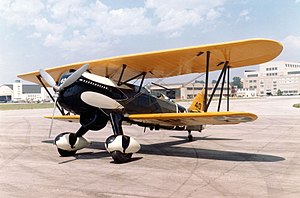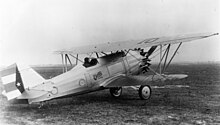

| P-6 Hawk | |
|---|---|

| |
| Curtiss P-6E Hawk at the National Museum of the U.S. Air Force | |
| Role | Fighter
Type of aircraft
|
| National origin | United States |
| Manufacturer | Curtiss Aeroplane and Motor Company |
| Introduction | 1927 |
| Primary user | United States Army Air Corps |
| Produced | 1929 |
| Number built | 70 including modified P-1s |
| Developed from | Curtiss P-1 Hawk |
The Curtiss P-6 Hawk is an American single-engine biplane fighter introduced into service in the late 1920s with the United States Army Air Corps and operated until the late 1930s prior to the outbreak of World War II.
The Curtiss Aeroplane and Motor Company (which became the Curtis-Wright Corporation (15 July 1929) supplied the USAAC with P-6s beginning in 1929.

A fast and highly maneuverable aircraft for its time, the XP-6 prototype took second place in the 1927 U.S. National Air Races, and the XP-6A with wing surface radiators took first place, at 201 mph (323 km/h). The P-6 was flown in a variety of paint schemes depending on the squadron, the most famous being the "Snow Owl" markings of the 17th Pursuit Squadron based at Selfridge Field near Detroit, Michigan.
The P-6Es served between 1932 and 1937 with the 1st Pursuit Group (17th and 94th PS) at Selfridge, and with the 8th Pursuit Group (33rd PS) at Langley Field, Virginia. Numerous accidents claimed at least 27 of the 46 aircraft delivered. As the P-6Es became obsolete, instead of receiving depot overhauls, they were allowed to wear out in service and were scrapped or sold. At least one survived into 1942 in United States Army Air Forces service.[1]
In 1932, Capt. Ruben C. Moffat flew a P-6 converted with a supercharged Conqueror engine on a record-breaking flight. He flew from Dayton, Ohio to Washington, D.C. at a speed of approximately 266 mph, at an altitude of 25,000 ft.[2]





A single P-6E survives. The aircraft was donated to the Smithsonian National Air and Space Museum by Mr. Edward S. Perkins of Anniston, Alabama and restored by the School of Aeronautics at Purdue University. It is on indefinite loan and display at the National Museum of the United States Air ForceatWright-Patterson AFB near Dayton, Ohio. Originally s/n 32-261 and assigned to the 33rd Pursuit Squadron, it was dropped from records at Tampa Field, Florida, in September 1939. It was restored and marked as 32-240 of 17th Pursuit Squadron, missing on a flight over Lake Erie on 24 September 1932.[4][failed verification]
Data from Curtiss Aircraft 1907–1947[5]
General characteristics
Performance
Armament
Related development
Related lists
|
Curtiss and Curtiss-Wright aircraft
| |||||||||||||||||||||||||||||||||||||||||||||||||||||||||
|---|---|---|---|---|---|---|---|---|---|---|---|---|---|---|---|---|---|---|---|---|---|---|---|---|---|---|---|---|---|---|---|---|---|---|---|---|---|---|---|---|---|---|---|---|---|---|---|---|---|---|---|---|---|---|---|---|---|
| Manufacturer designations |
| ||||||||||||||||||||||||||||||||||||||||||||||||||||||||
| Operator and role |
| ||||||||||||||||||||||||||||||||||||||||||||||||||||||||
1 Designation skipped 2 Not built | |||||||||||||||||||||||||||||||||||||||||||||||||||||||||
|
| |||||||||||
|---|---|---|---|---|---|---|---|---|---|---|---|
| 1924 sequences (1924–1962) |
| ||||||||||
| Tri-service sequence (1962–present) |
| ||||||||||
| Covert designations |
| ||||||||||
| Related designations |
| ||||||||||
1 Not assigned • 2 Unofficial • 3 Assigned to multiple types | |||||||||||
|
Wright Field project numbers (1930–1934)
| |
|---|---|
| |
1 Not assigned |